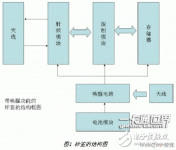
Point to take you in-depth understanding of microwave frequency band active RFID system design
[ad_1]
1 Introduction
RFID (RadioFrequeneyIdenTIficaTIon) radio frequency identification is a non-contact automatic identification technology, which automatically recognizes the target object and obtains relevant data through radio frequency signals. The identification work does not require manual intervention and can work in various harsh environments. The radio frequency identification system is mainly composed of a reader and an electronic tag. The data is stored in the electronic tag. When the electronic tag enters the effective range of the reader, the two parties can communicate according to a certain protocol. RFID technology can identify high-speed moving objects and can identify multiple tags at the same time, and the operation is quick and convenient. Short-distance radio frequency products are not afraid of harsh environments such as oil stains and dust pollution. They can replace barcodes in such environments, for example, to track objects on the assembly line of a factory. Long-distance radio frequency products are mostly used in traffic, and the identification distance can reach tens of meters, such as automatic toll collection or vehicle identification. In addition, since this technology is difficult to be counterfeited or invaded, the electronic tags have extremely high security protection capabilities. RFID has a wide range of applications. Typical applications currently include animal chips, automotive chip protectors, access control, parking lot control, production line automation, and material management. Countries and related international organizations are actively promoting the formulation of RFID technical standards. At present, there are no complete international and domestic standards for RFID. The current main RFID-related specifications include European and American EPC specifications, Japanese UID (UbiquitousID) specifications, and ISO 18000 series standards.
There are many types of RFID electronic tags, and their classification methods are diverse. According to the power supply method, it can be divided into active and passive electronic tags; according to the carrier frequency, it can be divided into low frequency (134.2kHz), high frequency (13.56MHz), ultra high frequency (433MHz and 915MHz), and microwave electronic tags (2.45GHz) Above); The individual technology of RFID electronic tags has matured, but there are still a lot of technical problems in the actual application of the logistics industry or the manufacturing industry. Such as: economy, signal interference, improvement of recognition rate, information security and privacy protection, standardization and other issues.
The basic RFID system is composed of RFID tags (Tag), RFID readers (Reader) and application support software. The CC2430 chip is supported by a powerful integrated development environment, and the interactive debugging of internal circuits is supported by the IAR industry standard that complies with the IDE, which is highly recognized by embedded institutions. It also applies to devices with 2.4 GHz frequency. CC2430 chip adopts O.18μm CMOS craft to produce, the electric current consumption when working is 27 mA; Under receiving and transmitting mode, the electric current consumption is lower than 27 mA or 25 mA respectively. It adopts 7 mm&TImes; 7mm QLP package with 48 pins in total.All pins can be divided into three types: I/O port line pins, power line pins and control line pins[5]. The sleep mode of CC2430 and the ultra-short time characteristics of transition to active mode are especially suitable for applications that require very long battery life. Especially suitable for the design of RFID systems. This article uses TI’s CC2430 as the core to design active RFID tags. Use 3, 3-4, 5V. It can be powered by a button battery, and the chip has low power consumption. Few peripheral circuits are required, high-frequency components are all integrated in the chip, and its working performance is stable and not affected by the outside world. It is very suitable for application environments that require low power consumption and high performance.
2. The hardware design of the label
2.1 Hardware circuit structure
A typical active RFID tag is composed of antenna, radio frequency module, control module, memory, wake-up circuit, battery module, etc. as shown in Figure 1. Among them, the radio frequency module completes the modulation and demodulation of the control signal and response signal between the tag and the reader. The controller executes the instructions of the reader. The memory stores the relevant information of the label and the control program of the single-chip microcomputer. The controller performs read and write operations on the memory. The radio frequency module includes a transmitting part and a receiving part. The transmitting part mainly consists of modulator, power amplifier, band-pass filter, mixer and local oscillator. The receiving part is composed of low-noise amplifier, band-pass filter, demodulator, detection and shaping, etc. TI’s CC2430 chip integrates all parts of the wireless communication system and only needs to add a few peripheral circuits to form a wireless communication module, which reduces the system cost and simplifies the design of the label. CC2430 chip is produced using O.18μm CMOS process, and the current consumption is 27 mA during operation; in the receiving and transmitting modes, the current consumption is lower than 27 mA or 25 mA, respectively. It is packaged in a 7 mm×7mm QLP package and has a total of 48 pins. All pins can be divided into I/O port line pins, power line pins and control line pins. The sleep mode of CC2430 and the ultra-short time characteristics of transition to active mode are especially suitable for applications that require very long battery life. Especially suitable for the design of RFID systems. The tag design matching circuit makes the output match the 50 ohm microstrip patch antenna. All surface mount components are used in PCB design, which simplifies the complexity of the system and the size of the label. The entire PCB is controlled within 10CM*5CM, which satisfies the miniaturization design of the label. The circuit diagram of the label is shown in Figure 2.

2.2 Low-power design of tags
For active tags, because they use battery power, the working life of the tags is limited, which requires the tags to save energy and have low power consumption. Thereby saving battery energy to extend the working life of the tag. CC2430 chip is produced using O.18μm CMOS process, and the current consumption is 27 mA during operation; in the receiving and transmitting modes, the current consumption is lower than 27 mA or 25 mA, respectively. Adding a certain control program in the label design process can make the label enter the working state only within the working range of the reader to respond to the query request of the reader. Thereby saving energy to the greatest extent.
2.3 Design of the reader
The reader should be connected to the computer application network. We use serial communication. Its maximum transmission distance is 30 meters. The communication rate is generally lower than 20kbps[7]. Since the serial ports on most MCU computers are RS-232C standard 9-pin interfaces. The MCU pins generally use TTL level for input/output, and the transmission quality is short and the transmission quality is poor. So we have to switch between these two different types. The electric level can correctly realize the communication connection between the reader and the computer. The circuit diagram of the reader is shown in Figure 3.
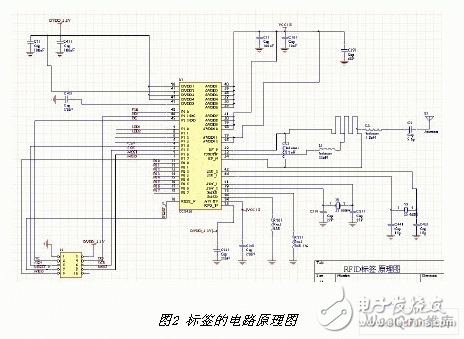
3. The software design of the label
3.1 Register settings
The important parameters of the RF part of the chip, such as: receiving address, sending and receiving frequency, wireless transmission rate, sending and receiving mode, etc., should be set in the corresponding register configuration word. The correct setting of these parameters can improve the efficiency and reliability of the label.
3.2 Label workflow
The label is in the power-off state at ordinary times, when the label enters the working area of the reader. The energy of the wake-up signal causes the power comparator to output a high level to activate the trigger to control the power chip to supply power to the main circuit. In this way, the tag controller reads the tag information from the memory at an appropriate time according to the anti-collision algorithm program, and then modulates it through the radio frequency module, amplifies it and transmits it through the antenna. When the reader correctly recognizes the tag, it will send the closing signal of the tag. After the tag is received, it will be judged. If the closing signal of the tag is the tag, the tag will no longer send information to the reader. When the tag leaves the working range of the reader. The trigger controls the power switch chip to power off the main working circuit of the tag. So as to achieve the purpose of energy saving. The workflow of the label is shown in Figure 4.
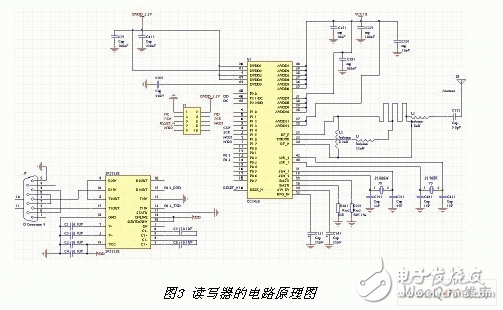
3.3 Computer-side software design
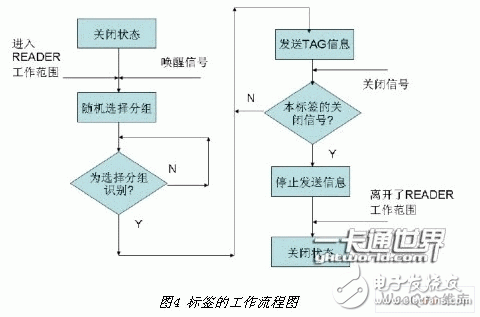
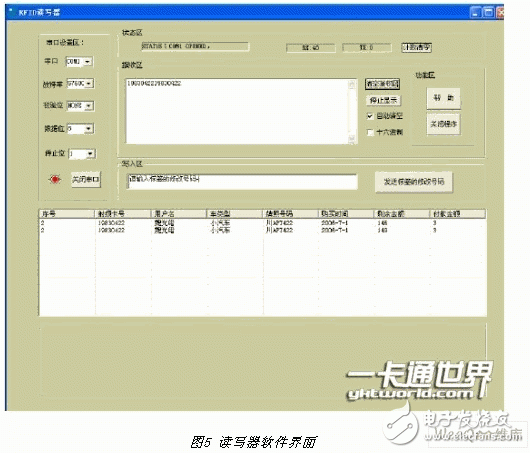
The software interface designed on the computer side is shown in the figure. It is composed of a serial port setting area, a communication status area, a receiving and sending area, and an ID information display area. When the tag receives the request of the reader, it sends its own information to the reader, receives the reader through the antenna and processes the information accordingly, and then sends it to the computer through the serial port. After the computer queries the corresponding information in the database for processing. The corresponding information is displayed on the software interface as shown in Figure 5.
[ad_2]


